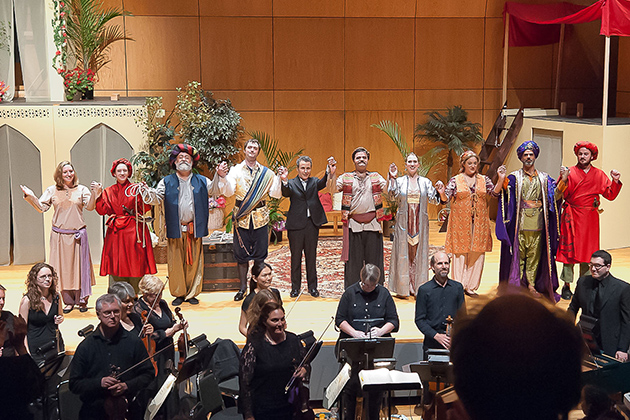
Music historian Eric Rice says the students in his classroom have had great musical experiences when they arrive at UConn from high schools throughout Connecticut. What they need to enhance their education, however, is an understanding of early music.
One way the head of the music department hopes to provide the state’s young musicians with exposure to music written and performed before 1800 is by expanding opportunities to hear the works of Bach, Mozart, Monteverdi, and others closer to home.
As artistic director of the annual Connecticut Early Music Festival, which is based in New London, Rice is again taking the show on the road this summer, beginning with a performance in Southport, a section of Fairfield in southwestern Connecticut.
“The impetus is to try and establish ties with venues in other parts of the state,” he says.
“There’s a great deal of educational work to be done,” he adds. He is also trying to add more and more school programs.
When we … look at old repertory in a new way, that’s a lot like trying to create something new on the contemporary side. –Eric Rice
This year’s Connecticut Early Music Festival will take place on consecutive weekends in June primarily in the New London area, but with a June 13 performance at 7:30 p.m. in Southport of “Disputatio – Music of the Crucifixion and Resurrection” performed by the baroque quartet Pallade Musica. The same program will take place the next evening at Christ the King Church in Old Lyme.
Rice links the performance series each year to a theme. This year the focus is on the intersection of religion with music and the musical culture of Europe, particularly during the Enlightenment period. It was a time when scientific thought was promoted, superstition challenged, and new ideas about government were developed that influenced the world.
“A broad theme can strike a chord across a great deal of music,” he says. “It’s a way to get people to think across the concerts we offer.”
Rice says interest in early music is expanding, as evidenced in part by the recent announcement of the start of a new festival in New York City, which already has several programs focused on such music. New York and Boston have a long history of supporting early music programs, he adds.
He notes that both early music and contemporary music are developing cultural intersections with styles of music that are already familiar to listeners – contemporary composers are using elements of jazz and popular music, and the influences of music from other parts of the world on the European roots of early music are heard by listeners who are familiar with the sound of world music.
“There is quite a lot overlap with world music, and recognition that European music is not monolithic and it had lots of influences from music all over the world that were brought about by politics and culture,” Rice says. “In many cases we can explore those intersections and traditions in a way that draws people who may be interested in music from a different part of the world into western European music.”
Original performance style
A key element in the presentation of early music is performing works as they would have sounded two centuries ago, which requires musicians who can play period instruments and with the techniques performed at that time. Rice says musicians regularly ask to participate in the Connecticut Early Music Festival so they can play Bach or Beethoven, but not all are familiar with how the music was originally performed.
“We’re interested in the performance of Bach in the style, so far as it’s knowable, in which he played,” says Rice, who studies archival records, critical reviews from newspapers of the time, and musicians’ diaries to learn the details of performances that took place before 1800.
As an example, Rice cites the scheduled performances of Haydn’s “Mercury” and Mozart’s “Jupiter” symphonies, which he will conduct to close the festival on June 22 at Connecticut College. Studies of late 18th-century performances indicate that the standard musical pitch of “A,” which orchestras use to tune their instruments, was a 430 pitch, 10 cycles lower than today’s standard of 440. The two works will use the lower pitch level. In some cases, the musicians also may need to make further adjustments with their period instruments.
“The horns, for example, will have no valves, so when we change keys from one piece to another, the musicians have to actually pull apart their horns and put in different crooks to get the proper pitch level,” he says. “These are all things we know about, and we hire the people who can perform on those types of instruments. When we back away from it for a minute and look at old repertory in a new way, that’s a lot like trying to create something new on the contemporary side.”
The Connecticut Early Music Festival will take place June 7-8, 13-15, and 20-22, and will include Purcell’s opera “Dido and Aeneas” and Monteverdi’s 1610 “Vespro della Beata Vergine,” with performances by the ensembles Rose of the Compass, Pallade Musica, and Istanpitta. For more information, go to www.ctearlymusic.org.



